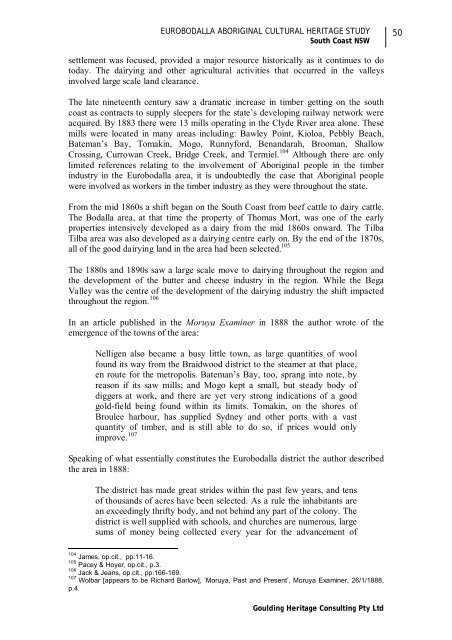Pages 9 - 77 (1600kb) - Eurobodalla Shire Council
Pages 9 - 77 (1600kb) - Eurobodalla Shire Council
Pages 9 - 77 (1600kb) - Eurobodalla Shire Council
You also want an ePaper? Increase the reach of your titles
YUMPU automatically turns print PDFs into web optimized ePapers that Google loves.
EUROBODALLA ABORIGINAL CULTURAL HERITAGE STUDY<br />
South Coast NSW<br />
settlement was focused, provided a major resource historically as it continues to do<br />
today. The dairying and other agricultural activities that occurred in the valleys<br />
involved large scale land clearance.<br />
The late nineteenth century saw a dramatic increase in timber getting on the south<br />
coast as contracts to supply sleepers for the state’s developing railway network were<br />
acquired. By 1883 there were 13 mills operating in the Clyde River area alone. These<br />
mills were located in many areas including: Bawley Point, Kioloa, Pebbly Beach,<br />
Bateman’s Bay, Tomakin, Mogo, Runnyford, Benandarah, Brooman, Shallow<br />
Crossing, Currowan Creek, Bridge Creek, and Termiel. 104 Although there are only<br />
limited references relating to the involvement of Aboriginal people in the timber<br />
industry in the <strong>Eurobodalla</strong> area, it is undoubtedly the case that Aboriginal people<br />
were involved as workers in the timber industry as they were throughout the state.<br />
From the mid 1860s a shift began on the South Coast from beef cattle to dairy cattle.<br />
The Bodalla area, at that time the property of Thomas Mort, was one of the early<br />
properties intensively developed as a dairy from the mid 1860s onward. The Tilba<br />
Tilba area was also developed as a dairying centre early on. By the end of the 1870s,<br />
all of the good dairying land in the area had been selected. 105<br />
The 1880s and 1890s saw a large scale move to dairying throughout the region and<br />
the development of the butter and cheese industry in the region. While the Bega<br />
Valley was the centre of the development of the dairying industry the shift impacted<br />
throughout the region. 106<br />
In an article published in the Moruya Examiner in 1888 the author wrote of the<br />
emergence of the towns of the area:<br />
Nelligen also became a busy little town, as large quantities of wool<br />
found its way from the Braidwood district to the steamer at that place,<br />
en route for the metropolis. Bateman’s Bay, too, sprang into note, by<br />
reason if its saw mills; and Mogo kept a small, but steady body of<br />
diggers at work, and there are yet very strong indications of a good<br />
gold-field being found within its limits. Tomakin, on the shores of<br />
Broulee harbour, has supplied Sydney and other ports with a vast<br />
quantity of timber, and is still able to do so, if prices would only<br />
improve. 107<br />
Speaking of what essentially constitutes the <strong>Eurobodalla</strong> district the author described<br />
the area in 1888:<br />
The district has made great strides within the past few years, and tens<br />
of thousands of acres have been selected. As a rule the inhabitants are<br />
an exceedingly thrifty body, and not behind any part of the colony. The<br />
district is well supplied with schools, and churches are numerous, large<br />
sums of money being collected every year for the advancement of<br />
104<br />
James, op.cit., pp.11-16.<br />
105<br />
Pacey & Hoyer, op.cit., p.3.<br />
106<br />
Jack & Jeans, op.cit., pp.166-169.<br />
107<br />
Wolbar [appears to be Richard Barlow], ‘Moruya, Past and Present’, Moruya Examiner, 26/1/1888,<br />
p.4.<br />
Goulding Heritage Consulting Pty Ltd<br />
50
















